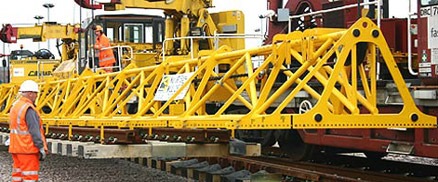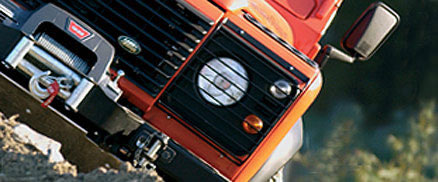June 22nd, 2010
The Pandrol® Fastclip is a new and revolutionary concept in rail fastening systems. It was computer developed to meet both current and future requirements of high speed, heavy haul and rapid transit operations. The Pandrol Fastclip system completely addresses
the need for fast, efficient track installation and reduced maintenance costs. The Pandrol Fastclip has met or exceeded every test and in-service performance demand. It is
pre-installed on concrete ties with pad and insulators in place, ready for track installation. Installation costs and long-term maintenance costs are significantly reduced.
Features
- All components pre-assembled on concrete ties
- Fast, fully mechanized installation and removal
- All components remain on the tie during rail change out or de-stressing
- Three positive locked positions
- Exceptional durability
- Excellent gage retention
- Exclusive two-piece insulators promote exceptionally long insulator life
- Larger bearing area of side post insulator distributes high lateral forces in curves
- Low stress, low profile design provides extended service life
- Can be used for turnouts
- No metal-to-metal contact at the clip/rail interface
- Hand tools available for manual installation
- Twin-stem or single-stem shoulder designs available
Installation and maintenance savings
The Pandrol® Fastclip system is pre-assembled at the tie manufacturer’s plant. Ties arrive at the job site with all components held securely in place. The clips, complete with toe insulators, have been pressed into the rail-ready position, where they hold the side post insulators and pads in place. Because of this railroads and contractors have realised significant installation savings. And that is just the beginning. The low-stress clip and dual insulator design result in extended component life and notable maintenance savings.
Posted in Arbil Rail |
June 22nd, 2010
MTK Series tractors require less air, making them less expensive to operate. They’re designed for use with any hoist, or even alone to push, pull, or position loads on beams.
- Up to 6 metric ton towing capacity
- Interchangeability with MLK Series and HLK Series parts
- Balanced gear package and air motor provide speeds from slow creep to 165 fpm
- Million-cycle performance tested air motor with spring-loaded vanes provides instant starting and slow speed control
- Heat-treated planetary gearing assures longer life and reduced maintenance
- Self-adjusting, spring-applied, non-asbestos disc brake is air-released for smooth starts and stops
- Drive tire is made from extremely durable polyurethane material with a temperature rating of 185° F for excellent adjustable gripping characteristics
- Tight turning radius of 30”
- Universal solid cast-iron wheels fit both flat and tapered beams
- Wheels can be greased for longer life
- Standard tractor fits 2.7” – 6.3” beam flange widths
- Roller guides made from high alloy steel keep tractor running smoothly
- Tractor operates with a full-flow pendent, enhancing load-spotting control
- Standard 7’ pendent length
- Tow bar included with tractor
Options available
- Free wheel kit that permits moving of tractor without supplying air; attaches directly to tractor without modification
- Wide flange kit fits 6.27 – 12” beam flange widths
- Pull chain operation
- Bronze wheels for spark-resistant applications
- Gasket repair and manual brake release kits
- Drawbar hitch kit
- External brake release kit relieves auto disc brake without running tractor
Posted in Arbil Lifting Gear |
June 22nd, 2010
A spade is not a spade when it comes to off-roading. Apart from it being the most important recovery tool, the spade must be designed right – garden spades work, but not nearly as well as those designed for the job. Ideally, an off-road spade should have a cupped
blade, more like a shovel, for removing mud or wet sand, for which a flat blade is very inefficient. A long handle will permit reaching well under the vehicle should it be caught on the axles or chassis but if it is too long it can be awkward. Collapsible camp shovels have handles far too short for digging out a vehicle. A pointed blade is better than square
as it is more suited to digging sand from under a tyre and provides easier penetration. It should also be painted a bright colour because spades are often left lying in the bush after a recovery operation and only found missing the next time someone gets stuck.
When selecting a spade consider the following:
- Feel the weight. It must not be unnecessarily heavy.
- The length should be sufficient to dig under a vehicle.
- Fold-away type camp shovels are far too short and make removing material from under a vehicle almost impossible.
- The blade should be a shovel-shaped. A flat blade is far less effective. The blade must not be too big – this adds weight and makes clearing under a vehicle more difficult.
- Fancy materials such as stainless steel are pointless – a spade is a spade, not a work of art. And, they get lost.
- Find a way of attaching your spade in a convenient place.
- Front-Runner make a nice roof-rack mount.
- Place the shovel on the side near the front of the rack so that the curve of the blade bends around the front corner. In this way it will not be caught by bushes that pass close to the vehicle.
Posted in Arbil 4x4 |
May 23rd, 2010
Special precautions need to be taken when working trackside with live electric cables. If you are involved with repair or are responsible for maintaining cables special precautions must be taken at all times to ensure employee safety. Once the cable has been made dead and then connected to earth at the point of supply, the cable is then cut, usually by a hacksaw or cable cutters.
In order to enable the spiking operation to be carried out in perfect safety, a cable spiker tool needs to be used as it has the great advantage that it can be remotely controlled at the moment of firing by means of a lanyard (rope) release. The operator using the spiker can stand at a point of safety and if accidentally a “live” cable is spiked, the damage will only be local to the cable. As the speed of penetration of the spiking punch is so rapid, it has been found in practice that even if a “live” cable is spiked, usually no damage to the cable spiker results. If however, the fault current happens to be extremely high, it may be that the actual spiking punch itself may suffer, but yet be capable of tripping a normally operating breaker. An added feature of the cable spiker is that the wide punch shears the cable partially or totally, depending on the cable size, hence reducing additional cable cutting effort.
The cable spiker is suitable for use with all types and voltages of power cable including single and multiple conductor laminated, polymeric, elastomeric, unshielded, shielded, concentric neutral, interlock armoured, steel wire armoured, leaded covered etc. designs in either fixed or portable installations.
The cable spiker is a quality durable tool designed to positively electrically ground out any required power cable for definite manpower accident prevention and life saving to anybody working with live cables.
Posted in Arbil Rail |
May 23rd, 2010
Shackles are used in lifting and static systems as removable links to connect (steel) wire rope, chain and other fittings. Screw pin shackles are used mainly for non-permanent applications. Safety bolt shackles are used for long-term or permanent applications or where the load may slide on the pin causing rotation of the pin. Chain or dee shackles are mainly used on one-leg systems whereas anchor or bow shackles are mainly used on multi-leg systems.
Van Beest offers a wide range of bow and dee shackles, depending on the application on which the shackle is going to be used; the range stretches from Working Load Limit (WLL) 0.33 tons to 1500 tons. Van Beest offer an extensive range to choose the shackle exactly suitable for the application. Most of the shackles are directly available from stock. Furthermore, shackles can be supplied to many standards such as the US Federal Specification RR-C-271, EN 13889, British Standard 3032, DIN 82101, DIN 82016 etc.
Polar shackles are for use in extreme climatic conditions with material properties guaranteed up to temperatures of -40oC, and furthermore we offer a wide range of general commercial shackles, which are not suitable for lifting but merely for fixing purposes.
All Van Beest shackles have a specific design for a specific application. Examples are the “Super” shackles which are made out of grade 8 steel enabling the dimensions of the shackles to be minimized for use in limited space conditions, without loss of functionality or Working Load Limit. Or sling shackles for use with large slings, to provide a better radius to the sling being used. Another example of functional design is the use of shackles where the pin has a square sunken hole so as not to obstruct the use of fishing nets. These are all examples of a highly functional design, to optimize the use of the Van Beest shackles in daily use.
Shackles supplied by Van Beest can be either hot dipped galvanized, electro-galvanized, painted or self coloured, depending on the type of shackle and its application.
Posted in Arbil Lifting Gear |


